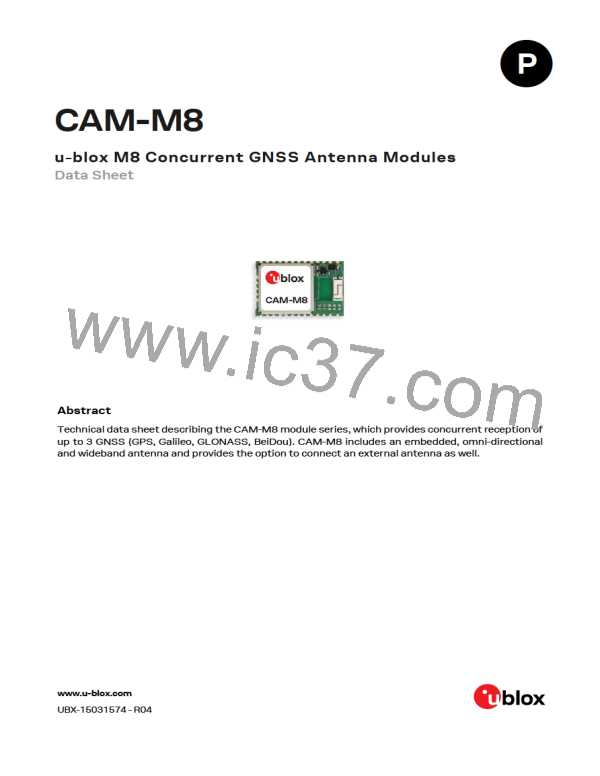CAM-M8 - Data Sheet
7.4.1 Moisture Sensitivity Levels
The Moisture Sensitivity Level (MSL) relates to the packaging and handling precautions required.
CAM-M8Q/C modules are rated at MSL level 4.
☞
For MSL standard see IPC/JEDEC J-STD-020. Download available at www.jedec.org.
For more information regarding MSL, see the u-blox Package Information Guide [3].
☞
7.4.2 Reflow soldering
Reflow profiles are to be selected according to u-blox recommendations (see the CAM-M8 Hardware
Integration Manual [1]).
7.4.3 Antenna ageing
Antenna electrode metallization is unprotected silver and will tarnish during storage due to sulfuric
compounds present in the atmosphere. Elevated temperature and humidity will accelerate this
process. Human skin contact, wool etc. will also cause tarnishing. This has no effect on the electrical
performance of the antenna. u-blox accepts no warranty claims for tarnished products due to this
normal and to be expected process.
7.4.4 ESD handling precautions
⚠
CAM-M8Q/C modules are Electrostatic Sensitive Devices (ESD). Observe handling precautions!
Failure to observe these precautions can result in severe damage to the GNSS receiver!
GNSS receivers are Electrostatic Sensitive Devices (ESD) and require special precautions when
handling. Exercise care when handling patch antennas, due to the risk of electrostatic charges. In
addition to standard ESD safety practices, take the following measures into account whenever
handling the receiver:
•
Unless there is a galvanic coupling between the local GND (i.e.
the work table) and the PCB GND, then the first point of
contact when handling the PCB must always be between the
local GND and PCB GND.
•
•
Before mounting an antenna patch, connect ground of the
device
When handling the RF pin, do not come into contact with any
charged capacitors and be careful when contacting materials
that can develop charges (e.g. patch antenna ~10 pF, coax
cable ~50-80 pF/m, soldering iron, …)
•
•
To prevent electrostatic discharge through the RF input, do
not touch any exposed antenna area. If there is any risk that
such exposed antenna area is touched in non ESD protected
work area, implement proper ESD protection measures in the
design.
When soldering RF connectors and patch antennas to the
receiver’s RF pin, make sure to use an ESD safe soldering iron
(tip).
UBX-15031574 - R04
Production Information
Product handling & soldering
Page 26 of 31

 U-BLOX [ u-blox AG ]
U-BLOX [ u-blox AG ]